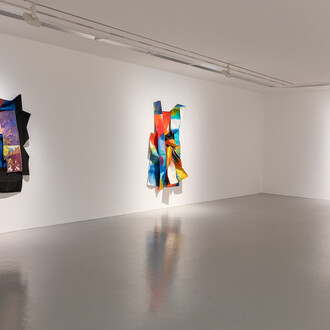The National Library of Ireland (NLI)’s National Photographic Archive launched ‘Portraits of the Invisible’, an exhibition of portrait photographs of Irish men and women involved in World War I.
The exhibition, held in partnership with the British Embassy, features a selection of the photographs collected and catalogued during a series of World War I roadshows since 2012. The NLI managed a number of roadshows with partners including Trinity College Dublin, RTE, and the Hunt Museum in Limerick. Some of the portraits featured in the exhibition were also collected at a roadshow organised by Wexford County Library, with support and advice provided by the NLI. The events were held as part of Europeana 1914-1918, an initiative that encouraged people across Europe to bring family letters, photographs and keepsakes from WWI to be catalogued and digitised.
‘Portraits of the Invisible’ features a selection of images of soldiers and medics, nurses and stretcher bearers, drivers and cyclists, sailors and pilots, accompanied by the stories their families have treasured for generations. In addition, audio recordings bring the words written by the participants in the war in their letters, postcards and diaries, to life.
Commenting today, exhibition curator Sara Smyth from the NLI, said: “Through our involvement with the Europeana World War I Project, we have been able to unearth and make publicly available an amazing body of material portraying the Irish experience of World War I.
“It has been a great privilege to meet Irish people whose families are in some way or other connected to the events that shook Europe between 1914 and 1918 and to hear their stories. For many of the contributors, the roadshows were their first opportunity to speak publicly about a relative’s involvement in WWI, others had only found out recently that family members had been involved, when a chance discovery in the attic revealed a piece of family history.
“This exhibition, in partnership with the British Embassy, shines a light on the Irish men and women of World War I, who made up a significant part of the British Armed Forces and volunteered at battlefronts across Europe and North Africa. The portrait photographs on display are by no means in pristine archival condition. Some are worn and battered having been carried around as a memento for decades; others show signs of prolonged exposure to light and some are in surprisingly good condition. However, they are an authentic representation of the memories of many Irish families and their involvement in WWI, documenting the unique Irish experience and preserving historical memory for generations to come.”
Among the Irish people whose portrait photographs are featured in the exhibition are:
• Frank Meyer from Bray, Co Wicklow, who took a circuitous route to the Western Front. He worked in Australia and New Zealand before emigrating to Canada in 1910. When the war broke out he was called up and was taken as prisoner of war by the Germans at the Battle of Julien in 1915. He made two attempts to escape, once getting within ten miles of the Dutch border before being recaptured. Frank was finally released in November 1918 and eventually returned to Canada but was always traumatised by his war-time experiences.
• Charles Budd from Dublin served in the Royal Army Veterinary Corps before the war, training in farriery, or how to shoe horses, at the Curragh Camp and Arbour Hill Barracks. In 1914, he became chief instructor of farriery at the Army Veterinary School in Aldershot. Charles made a major contribution to the care of army horses when he invented a training apparatus which allowed trainee farriers to shoe a horse without needing a live horse to train on. He received an MBE in 1919 for his invention.
• Malachy Moore, a Tipperary tailor, enlisted in the Royal Army Medical Corps to serve as a stretcher bearer. Gallipoli was Malachy’s first combat posting before serving in Egypt and Salonika, and during his hospital work a Serbian soldier gave him a Balkans War Medal, still treasured by his family. He became a patient himself when he contracted malaria and finished the war in a hospital bed. He returned to tailoring after the war and rarely spoke about this experiences. He did, however, write about his time at the front in a detailed poem entitled ‘Dog Biscuits and Bully’.
• Louisa Greany from Co Kerry trained as a nurse in Dublin and by 1914 was a private nurse in London. Volunteering for the British Red Cross Society, she was sent first to the Duchess of Westminster’s Hospital in Le Touquet and also nursed in Dinard’s Grand Casino, which served as a war-time hospital. Louise later transferred to Queen Alexandra’s Imperial Military Nursing Service Reserve as a Sister and served in Alexandria and Jerusalem. In 1917, she was made an Associate of the Royal Red Cross for exceptional services in military nursing.
Ambassador Dominick Chilcott and the British Embassy in Ireland
Speaking at the exhibition launch, British Ambassador Dominick Chilcott said: ““The contribution of ordinary Irish men and women did not feature much in accounts of the great battles or indeed of the overall war effort 100 years ago. This exhibition aims to correct that and bring the ‘common people’ out of the shadows of history.
This exhibition is part of the NLI’s work for the Decade of Centenaries. It offers a special insight into the experiences of individuals whose stories were previously only known to them and perhaps their families. This exhibition will add a very human dimension to our understanding of World War I and the Irish experience of it. It fits very well with the NLI’s earlier exhibition ‘World War Ireland: Exploring the Irish Experience’, which was launched at the NLI last November and will run for the next three years.
I am delighted that the British government has been able to make its contribution to both these NLI exhibitions.”

















